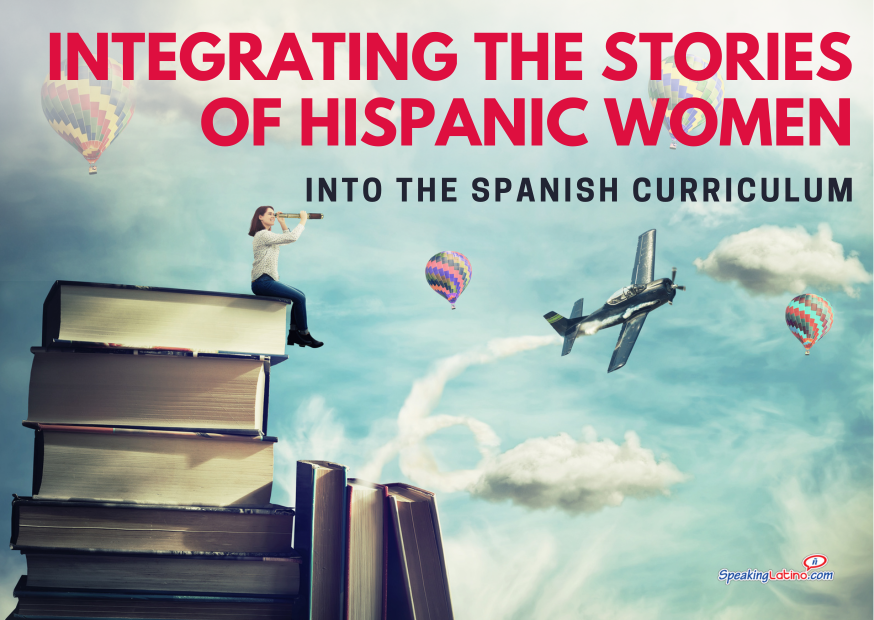
The content of this article is based on the presentation, Making Hispanic Women Count in the Spanish Curriculum by Carmen Reyes, which was part of the World Language Teacher Summit.
The Impact of Hispanic Women's Stories in Spanish Learning
The importance of diversity and inclusion in the classroom cannot be overstated. A comprehensive Spanish curriculum that celebrates the contributions of Hispanic women not only enriches students' learning experience but also serves as a powerful tool for empowerment and combating stereotypes.
The inclusion of personal stories and the achievements of Hispanic women in educational content inspires students of all backgrounds to dream big and recognize the value of representation.
The Imperative of Representation in Education
The historical underrepresentation of women in recorded history extends to the modern-day curriculum, where stories of men typically overshadow those of women. This imbalance is particularly notable in the context of Hispanic women, whose achievements and contributions often remain under the radar.
Introducing stories of influential Hispanic women in lessons is not just about ensuring fairness or balance but about shaping an empowering narrative that resonates with all students.
Strategies for Incorporating Hispanic Women Achievers
Integrating Hispanic women into the Spanish curriculum involves using innovative strategies that engage and motivate students. Teachers can employ various methods, including categorization, interactive games, and discussions to bring these stories to the forefront of education.
Categorization Method
Developing a categorized list of important Hispanic women achievers by different topics aids in systematically incorporating their stories into the curriculum. This method encourages educators to explore and present information in a structured manner that aligns with relevant educational themes such as space exploration, social issues, environmental conservation, and more.
Interactive Learning through Games
Interactive games that involve guessing the identity of Hispanic women achievers based on clues about their name, country, and occupation can transform the learning experience. Such activities not only bolster students’ inference skills but also pique their curiosity about the impactful lives of these women. Through gamification, students learn about these influential figures in a dynamic and memorable way.
Enhancing Engagement with Personal Stories
Sharing personal narratives and accounts of Hispanic women from various fields fosters an emotional connection that textbooks often cannot achieve. When students hear about individuals who share similar cultural backgrounds surmounting obstacles and making significant strides, it serves as a source of motivation and encourages them to dream without limits.
Empowerment Through Role Models
The celebration of Hispanic women in the curriculum is not limited to famous personalities; it extends to those in local communities who serve as role models. By highlighting the achievements of Hispanic women from a variety of professions and societal roles, students learn that excellence and inspiration can be found in everyday encounters.
Cultural Immersion via Literature
Literature is a splendid avenue for students to delve into the lives of notable Hispanic women. For instance, books like My Name is Gabriela invite students to explore the journey of Gabriela Mistral, a Chilean poet-diplomat, educator, and feminist.
These literary works allow students to immerse themselves in other cultures while learning about figures who have made history against the odds.
Tangible Role Models in the Curriculum
The inclusion of tangible role models in the curriculum such as Aracely Quispe Neira, an air and space engineer from Peru working at NASA, and Clara Elizabeth Fragoso Ugarte, a truck driver from Mexico, does more than just tell a story. These women exemplify breaking gender norms and advocating for equality, thereby enriching curriculum topics such as space, planet, and earth.
Highlighting such stories demonstrates to students the diversity of career paths and the impact one can have in various fields, regardless of gender.
Impact Stories in Environmental Science
Environmental science provides a fertile ground to discuss the work of Hispanic women like Sofia Sofía Heinonen, an Argentinian conservationist. By focusing on her efforts to safeguard biodiversity and wetlands in South America, lessons take on an added dimension, reflecting the passion and commitment of individuals dedicated to preserving our planet. The curriculum expands to embody topics like environmental stewardship, geography, and climate change, with a human aspect at its core.

Literature is a splendid avenue for students to delve into the lives of notable Hispanic women
Asserting the importance of strong women in the curriculum, not necessarily world-renowned ones, is essential in shaping how students perceive influence and success. Exceptional women like Marcela Fernández, a Colombian expeditionist who champions the awareness of vanishing glaciers, serves as a testament to the impact one person can make.
Integrating such narratives into topics concerning geography, conservation, and cultural studies generates a more inclusive and representative educational environment.
FAQs About Integration of Hispanic Women Achievers Into the Spanish Curriculum
How can educators effectively incorporate the stories of Hispanic women achievers into the Spanish curriculum?
Educators can effectively incorporate the stories of Hispanic women achievers into the Spanish curriculum through various strategies:
- Utilize Categorization: Organize a list of important Hispanic women achievers based on different topics such as their names, country of origin, field of expertise, and occupation to facilitate easy integration into curricular themes.
- Engage Students Through Games: Implement interactive games where students guess the name, country, and occupation of a Hispanic woman achiever based on provided clues, sparking interest and curiosity in their stories.
- Provide Accessible Resources: Ensure educators have access to a list of Hispanic women achievers that can be seamlessly incorporated into lesson plans and activities throughout the school year.
- Highlight Inspirational Stories: Share stories of Hispanic women who have fought for their dreams and ideals, emphasizing their resilience and achievements as sources of inspiration for students.
- Foster Connection and Empowerment: Create a classroom environment where students feel connected to the stories of Hispanic women achievers, empowering them to believe in their own potential for success.
Why is it important to highlight the contributions of Hispanic women in Spanish language education?
It is important to highlight the contributions of Hispanic women in Spanish language education for several reasons:
- Representation and Diversity: By showcasing the achievements and stories of Hispanic women, educators can provide a more diverse and inclusive representation of Hispanic culture in the curriculum, reflecting the richness and complexity of the Spanish-speaking world.
- Empowerment and Inspiration: Highlighting the contributions of Hispanic women can empower students, especially young girls, by offering them role models to look up to and inspiring them to pursue their own goals and dreams.
- Historical Balance: Addressing the historical imbalance that often focuses more on male achievements in traditional education and literature, incorporating the narratives of Hispanic women helps to provide a more balanced and comprehensive view of history and culture.
- Cultural Appreciation: By recognizing the contributions of Hispanic women, students can gain a deeper appreciation for the diverse perspectives, experiences, and accomplishments within the Hispanic community, fostering cultural understanding and respect.
- Educational Enrichment: Integrating the stories of Hispanic women achievers into the curriculum can enhance students' learning experiences, sparking interest, curiosity, and critical thinking skills as they engage with diverse narratives and perspectives.
Overall, highlighting the contributions of Hispanic women in Spanish language education not only promotes diversity and inclusion but also empowers students, enriches their educational experiences, and fosters a deeper understanding and appreciation of Hispanic culture and history.

By highlighting the achievements of Hispanic women from a variety of professions and societal roles, students learn that excellence and inspiration can be found in everyday encounters
What role do personal stories of Hispanic women play in enriching students' learning experiences?
Personal stories of Hispanic women play a significant role in enriching students' learning experiences in the following ways:
- Cultural Relevance: Personal stories provide students with authentic and relatable narratives that connect them to the lived experiences of Hispanic women, making the content more engaging and culturally relevant.
- Humanizing History: By sharing personal stories, educators humanize historical events and achievements, allowing students to see the individuals behind the facts and statistics, fostering empathy and a deeper understanding of the human experience.
- Inspiration and Motivation: Hearing about the challenges, triumphs, and perseverance of Hispanic women can inspire and motivate students to overcome obstacles, set goals, and strive for success in their own lives.
- Critical Thinking: Analyzing personal stories encourages students to think critically about societal norms, gender roles, and cultural expectations, prompting discussions on diversity, equity, and inclusion.
- Identity Formation: Personal stories help students explore their own identities and cultural heritage, encouraging self-reflection and a deeper appreciation of their roots and the contributions of Hispanic women to society.
- Empowerment: Listening to personal stories of resilience and achievement empowers students to believe in their own potential, fostering a sense of agency and confidence in their abilities.
Incorporating personal stories of Hispanic women into the curriculum not only enhances students' understanding of history and culture but also promotes empathy, critical thinking, cultural appreciation, and self-empowerment, ultimately enriching their overall learning experiences.
Inspiring Tomorrow's Leaders: The Role of Hispanic Women's Stories in Education
Incorporating the stories and achievements of Hispanic women in the Spanish curriculum is indispensable in fostering a diverse and inclusive educational landscape. Through innovative teaching strategies, literature, personal narratives, and the acknowledgment of both celebrated and community heroes, educators create a learning experience that not only reflects the true tapestry of our society but also empowers students to become active, informed, and culturally sensitive individuals. It is through these stories that students learn to appreciate the power of diversity, understand their rich heritage, and are inspired to reach for their own stars.
Discover more language teaching techniques to help you in your classroom.